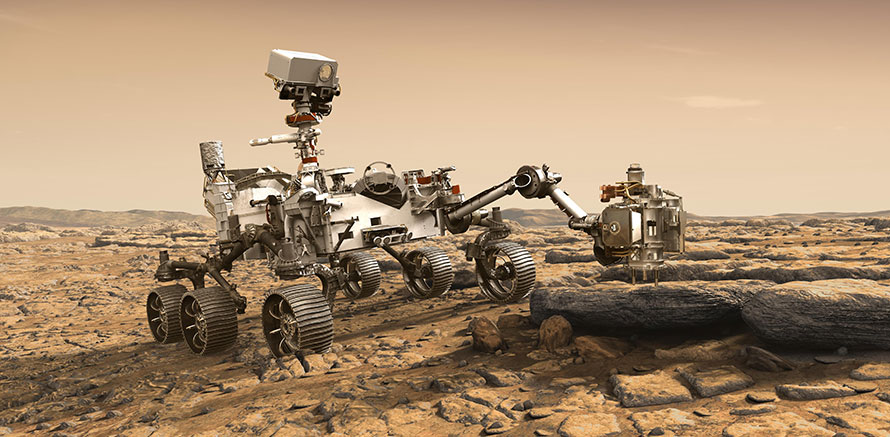Satellites orbiting Mars and robotic landers, supplemented if needed by rovers teleoperated by an orbiting crew, determining the location, nature and extent of Martian resources, especially ice, guiding the choice of the best sites for follow-on human missions.
 The Mars 2020 rover will include the Mars Oxygen In-Situ Resource Utilization Experiment (MOXIE) to demonstrate the production of oxygen from the Martian atmosphere for propellant and for breathing. Image: NASA
The Mars 2020 rover will include the Mars Oxygen In-Situ Resource Utilization Experiment (MOXIE) to demonstrate the production of oxygen from the Martian atmosphere for propellant and for breathing. Image: NASA
DESCRIPTION
Robotic missions to Mars, both orbiters and landers, have provided and are currently providing tantalizing hints about Martian geological history. Continuing missions, utilizing the favorable launch windows that occur about every 26 months, may be entirely robotic or supplemented by crewed missions to a Martian moon or even low Mars orbit. From this location the crew could (a) teleoperate Mars landers without the long delay in radio transmissions to and from Earth, (b) explore that moon, and (c) test equipment that later could be used on Mars. Unless (by the time we are ready for the first human landing on Mars) we have identified a clearly superior landing site for the initial human surface base, such a crewed orbital mission may be needed to teleoperate rovers to determine “ground truth” about which site is best.
There are two fundamental objectives of such missions:
1. Scientific Knowledge. One fundamental objective of these missions will be to continue to learn more and more about the planet’s geological history, both to understand it for its own scientific value and to ascertain if there are any implications as to Earth’s own history and future. In particular, these missions would be searching for:
- The existence of Martian life of any kind.
- Evidence of past Martian life, now extinct.
- Exact locations, purity and amounts of surface and buried ice or liquid water, especially near the surface and near the equator.
- Locations with thick layers of rocks for dating to provide an accurate geological history.
- Geological implications from diverse soil and rock samples that help us compare the Earth to Mars.
- Locations and amounts of valuable minerals and metal ores such as hematite.
- An understanding of Martian weather, seasons and atmosphere.
- Indications of any biological or other contaminants that could be harmful if returned to Earth.
- Rates of loss of the Mars atmosphere from solar wind stripping and photolysis of water.
2. Data for Human Exploration and Outposts. The other fundamental objective of these robotic Mars missions will be to be ascertain existing conditions that are favorable or unfavorable to human exploration and settlement on the planet, especially near the Martian equator where less fuel is required to land and return to orbit. In particular, these missions would:
- Search for the best sites for follow-on human activities.
- Search for ice or water sources that will be the most accessible to humans.
- Search for any deep brine layers and concentrations of other minerals that might be useful to humans.
- Test a wide variety of materials and machines against the Martian environment, to determine how well they will remain sturdy and operable over long periods of time, while exposed to wind, dust, radiation, daily temperature fluctuations, and seasonal changes.
- Test various robotic rover designs in ever longer traverses over varied Martian terrain.
- Test prototypes of in situ resource utilization (ISRU) equipment to (1) automatically convert Martian carbon dioxide and excavated ice to fuels (including rocket propellants) and oxygen and (2) eventually convert solid minerals into structural materials.
- Test a variety of energy supply and backup systems.
- Test automatic and/or teleoperated equipment designed to excavate and transport ice to a fuel production plant.
- Test automatic construction techniques both in and using Martian soil.
- Test for the best methods for growing food plants on Mars, on the surface or below ground.
With favorable launch windows existing only about every 26 months, determining the tradeoffs as to which measuring instruments and which test equipment and which rovers will be sent on any particular mission, and in what order, will provide challenges for policy makers.
COMPLETION
The first objective of this milestone (scientific knowledge) may never be fully completed, as scientific investigation is open-ended. The second objective (exploration and outpost data) can be considered achieved when there is agreement on at least three viable surface sites for future human development, all of which have an ice source nearby.
MORE OF THE NSS ROADMAP TO SPACE SETTLEMENT:







